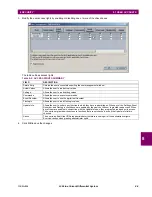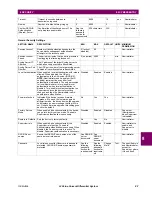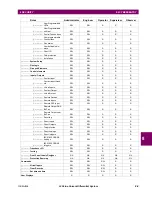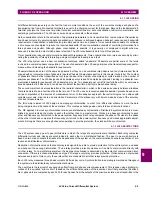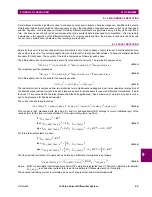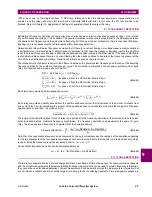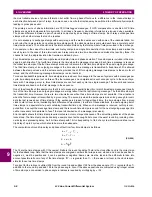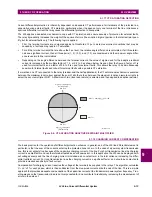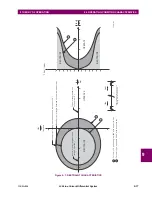
9-2
L30 Line Current Differential System
GE Multilin
9.1 OVERVIEW
9 THEORY OF OPERATION
9
other relay terminals. Also, the sum of the squares of the raw data samples is computed for each phase, and transmitted
with the phaselets.
At the receiving relay, the received phaselets are combined into phasors. Also, ground current is reconstructed from phase
information. An elliptical restraint region is computed by combining sources of measurement error. In addition to the
restraint region, a separate disturbance detector is used to enhance security.
The possibility of a fault is indicated by the detection of a disturbance as well as the sum of the current phasors falling out-
side of the elliptical restraint region. The statistical distance from the phasor to the restraint region is an indication of the
severity of the fault. To provide speed of response that is commensurate with fault severity, the distance is filtered. For mild
faults, filtering improves measurement precision at the expense of a slight delay, on the order of one cycle. Severe faults
are detected within a single phaselet. Whenever the sum of phasors falls within the elliptical restraint region, the system
assumes there is no fault, and uses whatever information is available for fine adjustment of the clocks.
9.1.3 REMOVAL OF DECAYING OFFSET
The inductive behavior of power system transmission lines gives rise to decaying exponential offsets during transient con-
ditions, which could lead to errors and interfere with the determination of how well measured current fits a sinewave.
The current signals are pre-filtered using an improved digital MIMIC filter. The filter removes effectively the DC compo-
nent(s) guaranteeing transient overshoot below 2% regardless of the initial magnitude and time constant of the dc compo-
nent(s). The filter has significantly better filtering properties for higher frequencies as compared with a classical MIMIC filter.
This was possible without introducing any significant phase delay thanks to the high sampling rate used by the relay. The
output of the MIMIC calculation is the input for the phaselet computation. The MIMIC computation is applied to the data
samples for each phase at each terminal. The equation shown is for one phase at one terminal.
9.1.4 PHASELET COMPUTATION
Phaselets are partial sums in the computation for fitting a sine function to measured samples. Each slave computes phase-
lets for each phase current and transmits phaselet information to the master for conversion into phasors. Phaselets enable
the efficient computation of phasors over sample windows that are not restricted to an integer multiple of a half cycle at the
power system frequency. Determining the fundamental power system frequency component of current data samples by
minimizing the sum of the squares of the errors gives rise to the first frequency component of the Discrete Fourier Trans-
form (DFT). In the case of a data window that is a multiple of a half cycle, the computation is simply sine and cosine
weighted sums of the data samples. In the case of a window that is not a multiple of a half-cycle, there is an additional cor-
rection that results from the sine and cosine functions not being orthogonal over such a window. However, the computation
can be expressed as a two by two matrix multiplication of the sine and cosine weighted sums.
Phaselets and sum of squares are computed for each phase at each terminal as follows. For the real part, we have:
(EQ 9.1)
For the imaginary part, we have:
(EQ 9.2)
where:
k
is the present phaselet index,
N
is the number of samples per cycle, and
p
is the present sample index
The computation of phaselets and sum of squares is basically a consolidation process. The phaselet sums are converted
into stationary phasors by multiplying by a precomputed matrix. Phaselets and partial sums of squares are computed and
time stamped at each relay and communicated to the remote relay terminals, where they are added and the matrix multipli-
cation is performed. Since the sampling clocks are synchronized, the time stamp is simply a sequence number.
I
1_Re_
A k
4
N
----
i
1_
f
_
A k p
–
p
0
=
N
2
1
–
=
2
p
1 2
+
N
--------------------------------
cos
I
1_Im_
A k
4
N
----
–
i
1_
f
_
A k p
–
p
0
=
N
2
1
–
=
2
p
1 2
+
N
--------------------------------
sin
Summary of Contents for L30
Page 10: ...x L30 Line Current Differential System GE Multilin TABLE OF CONTENTS ...
Page 30: ...1 20 L30 Line Current Differential System GE Multilin 1 5 USING THE RELAY 1 GETTING STARTED 1 ...
Page 370: ...5 244 L30 Line Current Differential System GE Multilin 5 10 TESTING 5 SETTINGS 5 ...
Page 464: ...A 10 L30 Line Current Differential System GE Multilin A 1 PARAMETER LISTS APPENDIX A A ...
Page 600: ...C 30 L30 Line Current Differential System GE Multilin C 7 LOGICAL NODES APPENDIX C C ...
Page 610: ...D 10 L30 Line Current Differential System GE Multilin D 1 IEC 60870 5 104 APPENDIX D D ...
Page 622: ...E 12 L30 Line Current Differential System GE Multilin E 2 DNP POINT LISTS APPENDIX E E ...
Page 634: ...F 12 L30 Line Current Differential System GE Multilin F 3 WARRANTY APPENDIX F F ...
Page 644: ...x L30 Line Current Differential System GE Multilin INDEX ...






